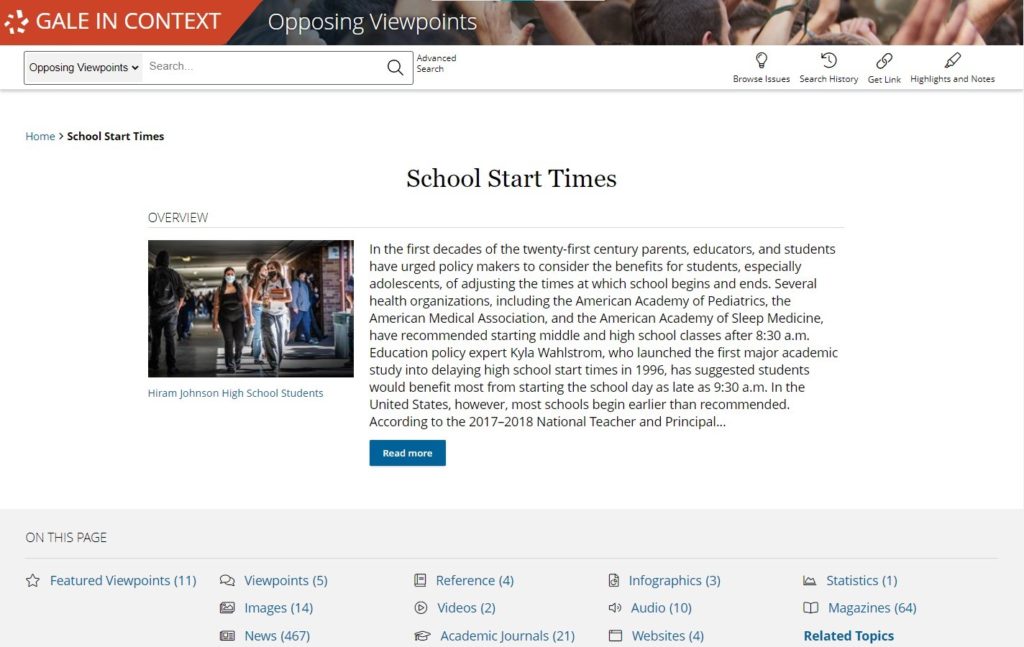| By Gale Staff |
It’s difficult for most of us to say goodbye to summer, whether you’re a student or an educator. How do you get young minds to transition out of vacation mode and tune in to what’s happening in the classroom? Give them something to talk about, of course!
Getting off on the right foot—with captivating content and meaningful interactions through lively debate—is a great segue into the school year. Gale In Context: Opposing Viewpoints can help, with content built around important and trending topics. Looking beyond the initial engagement, classroom debates can help your students learn how to build persuasive arguments, sharpen critical-thinking skills, and consider different points of view.
This month, we’re highlighting relatable, school-themed debate topics for teachers and librarians to consider, helping you make the most out of your transition into the new school year. Each topic within this blog is associated with a Gale product link, to give students and educators a jump start on classroom discussion, including an in-depth look at many of the salient points presented below. It’s a sample of the rich and varied topical content Gale In Context: Opposing Viewpoints has to offer.
School start times—how early is too early?
Several health organizations, including the American Academy of Pediatrics, the American Medical Association, and the American Academy of Sleep Medicine, recommend later start times for middle school and high school students. Some even insist that school should start as late as 9:30 a.m. However, according to a survey conducted by the National Center for Education Statistics, the number of middle schoolers and high schoolers starting school before 8:30 hovers at around 80 percent.
Recommendations for adequate sleep for teens and tweens range from 8.5–9.25 hours per night. Kids who get enough sleep have less trouble with attention, behavior, learning, memory, and emotional regulation. Essentially, getting the right amount of sleep isn’t just about learning—some argue it’s intrinsically tied to the quality of life associated with mental and physical health.
Many teens are night owls, in part due to physical changes that occur during adolescence causing them to both wake up and fall asleep later—making early school start times a bad fit. As you might expect, not getting enough sleep has a negative effect on student well-being and can lead to unhealthy habits, such as excessive caffeine consumption, nicotine use, and poor dietary choices. Proponents of late start stress the benefits of better overall health, improved school performance, stress management, and decision-making.

It’s no surprise, then, that medical professionals, school administrators, and others are considering changing to late starts five days per week. So why haven’t all schools migrated to this model? Of course, these schedules are put in place to support working parents; staggered district bus schedules; and extracurricular after-school activities, including school sports. But what do your students have to say? Would a few more hours of sleep help them be more prepared for class? How would they like to see their school day structured? Why do they think some groups are opposed to the change?
Cell phones in schools—how much is too much?
Cell phones have become a big part of students’ lives—between 2004 and 2016, the number of teenagers who owned cell phones jumped by a little less than half to 90 percent. As smartphone technology offers unrestricted access to the internet, it has become more integrated into American life. In fact, 92 percent of children ages 13–16 reported owning a smartphone or having regular access to a smartphone. Given these stats, there’s intense debate about whether cell phones have a place in the classroom. It’s a controversial topic, posing both problems and opportunities for educators.
Many educators argue that cell phones can and should be used for educational purposes, from retrieving information on the internet to organizing notes and assignments. For many students, it’s a way to stay in close contact with parents, employers, coaches, and classmates—improving relationships and time-management skills.
Of course, there’s another side to cell phone use in schools, and that is engagement with these electronic devices to the point of distraction. Much of the debate over cell phone use centers around its impact on school environments. Texting, social media, gaming, and other forms of entertainment detract from learning. In 2018, according to Pew, 45 percent of teenagers used the internet almost constantly. For this reason and others, some studies suggest that cell phone use leads to poorer learning outcomes. Child development experts also point to diminished social skills; inappropriate behaviors, including cyberbullying; and increased anxiety and depression.
With so many students keeping these devices close, exploring this topic in the classroom could be a great opportunity to capture their attention. Do they think their school’s current policy on cell phones is appropriate? What subjects are enhanced by cell phone use?
School uniforms and dress codes—what’s fair to wear?
Today, school uniforms are becoming increasingly common at public schools in the United States. The U.S. Department of Education’s National Center for Educational Statistics (NCES) claims that during the 2017–2018 school year, nearly 20 percent of all public schools required students to wear uniforms. The balance of these requirements rested with charter schools, followed by traditional public schools. School uniforms are also prevalent in urban areas among racial and ethnic minority groups, exceeding 50 percent who received free or low-cost lunches.
School dress codes establish rules around what types of clothing to wear rather than requiring a specific outfit for school. Skirt length, certain types of jewelry, and offensive T-shirts are all up for consideration, and may be viewed as inappropriate or distracting. Many see a direct link between improved academic performance, attendance, and behavior and established dress codes or uniform policies. In 1994, a school in California, for example, implemented uniform policies for grades K–8, noting that within one year, school fights had decreased by 51 percent, and drug use had decreased by 69 percent within the Long Beach Unified School District.

The policy has its critics. Some researchers found no significant impacts on attendance, behavior, substance abuse, academic achievement, and more—citing that it was collective changes to school environments that inspired positive changes. Many state that school uniforms and dress codes also restrict students’ freedom of expression, promote conformity, and stifle creativity. In some private school environments, students are required to wear expensive uniforms available from niche shops, putting undue financial burden on parents who might rely on financial aid to pay their children’s tuition.
Clothing choices are as individualized as the teens and tweens who wear them. How do students see uniforms versus dress code policies? Would they attend a school with either of these policies?
Get your students talking!
Giving students a sense of ownership through healthy debate about topics that matter to them is an excellent way to start the school year. Gale databases like Gale In Context: Opposing Viewpoints offer credible content; leveled overviews of the topics for students of different reading abilities; and multimedia, such as audio and video, which can help them frame and support lively classroom debates around issues they face every day. It’s also worth mentioning that the portal overviews supported in this piece are available for Lexiles 5 and 4, to better support readers at different levels.

